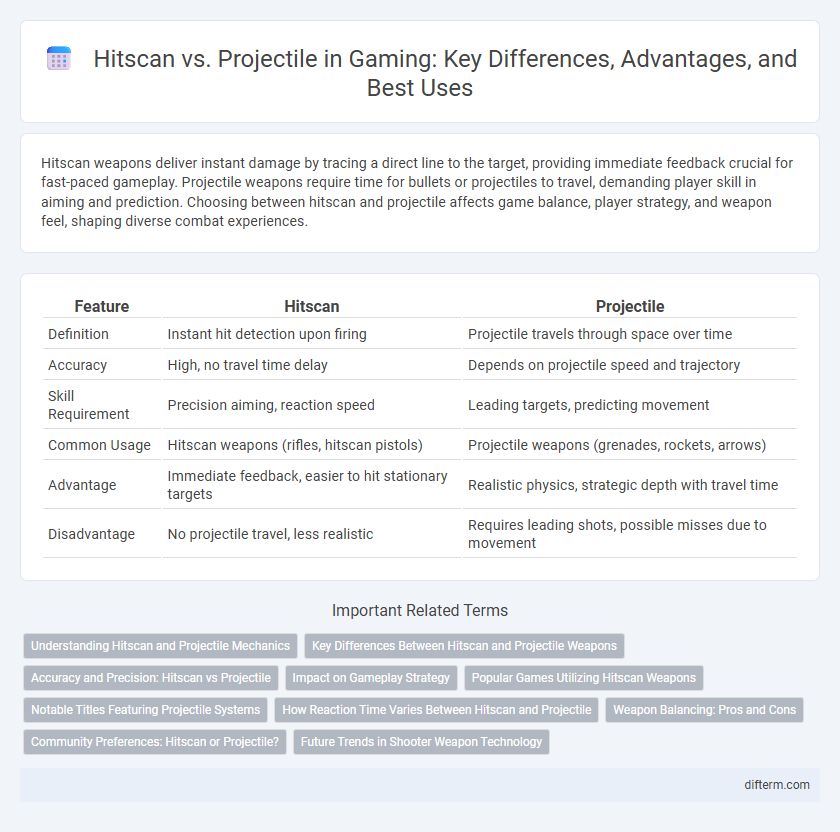Hitscan weapons deliver instant damage by tracing a direct line to the target, providing immediate feedback crucial for fast-paced gameplay. Projectile weapons require time for bullets or projectiles to travel, demanding player skill in aiming and prediction. Choosing between hitscan and projectile affects game balance, player strategy, and weapon feel, shaping diverse combat experiences.
Table of Comparison
| Feature | Hitscan | Projectile |
|---|---|---|
| Definition | Instant hit detection upon firing | Projectile travels through space over time |
| Accuracy | High, no travel time delay | Depends on projectile speed and trajectory |
| Skill Requirement | Precision aiming, reaction speed | Leading targets, predicting movement |
| Common Usage | Hitscan weapons (rifles, hitscan pistols) | Projectile weapons (grenades, rockets, arrows) |
| Advantage | Immediate feedback, easier to hit stationary targets | Realistic physics, strategic depth with travel time |
| Disadvantage | No projectile travel, less realistic | Requires leading shots, possible misses due to movement |
Understanding Hitscan and Projectile Mechanics
Hitscan mechanics register a hit instantly when a trigger is pulled, detecting collision along a straight line from the weapon to the target, ensuring immediate feedback and precise aiming. Projectile mechanics simulate physical objects traveling through space with velocity, arc, and drop, requiring players to predict movement and lead targets for effective hits. Understanding the fundamental differences in travel time and hit registration helps players adapt strategies and improve accuracy in various game genres.
Key Differences Between Hitscan and Projectile Weapons
Hitscan weapons instantly register a hit upon firing by tracing a straight line to the target, making them ideal for fast-paced gameplay and precise shooting. Projectile weapons fire objects that travel through space and time, introducing travel time and drop, which requires players to lead targets and account for distance. The key differences involve hit registration speed, required aiming skill, and how each weapon type interacts with movement and latency in gaming environments.
Accuracy and Precision: Hitscan vs Projectile
Hitscan weapons register instant hits, delivering high accuracy and precision by simulating a direct line-of-sight shot, ideal for fast-paced gaming scenarios. Projectile weapons require accounting for travel time and bullet drop, challenging players to predict motion and distance for precise targeting. Mastery of hitscan ensures immediate impact, while projectile proficiency rewards skillful anticipation and timing for accuracy.
Impact on Gameplay Strategy
Hitscan weapons deliver instantaneous damage upon firing, favoring fast-reaction gameplay and precision aiming, which benefits players with quick reflexes. Projectile weapons require prediction of target movement due to travel time, encouraging strategic positioning and anticipatory playstyles. Understanding these mechanics influences weapon choice, dictating offensive tactics and defensive maneuvers in competitive gaming scenarios.
Popular Games Utilizing Hitscan Weapons
Popular games utilizing hitscan weapons include Counter-Strike: Global Offensive, Valorant, and Call of Duty, where instant-hit mechanics enhance precision and responsiveness. Hitscan weapons calculate bullet registration at the exact moment of firing, allowing for fast-paced gameplay and immediate feedback. This system contrasts with projectile weapons, which require players to predict bullet travel time and drop, adding a layer of skill and complexity.
Notable Titles Featuring Projectile Systems
Notable titles featuring projectile systems include Overwatch, Valorant, and Apex Legends, where weapons rely on realistic travel time and projectile arcs. These games emphasize skill-based aiming and predictive movement to land shots effectively. Projectile mechanics enhance gameplay depth by requiring players to account for bullet drop and travel speed.
How Reaction Time Varies Between Hitscan and Projectile
Reaction time in gaming significantly differs between hitscan and projectile weapons, as hitscan weapons register hits instantly upon trigger pull, eliminating any delay between shot and impact. Projectile weapons require players to anticipate target movement and lead their shots due to travel time, demanding quicker predictive skills and spatial awareness. This dynamic influences player strategy, emphasizing reflex speed for hitscan and foresight for projectile-based combat.
Weapon Balancing: Pros and Cons
Hitscan weapons offer instantaneous hit detection, making them ideal for balanced gameplay where precision and reaction time are key, but they can feel less fair in lag-prone environments. Projectile weapons introduce travel time and drop-off mechanics, which allow for skill-based prediction and strategic depth, yet they risk frustrating players due to missed shots caused by latency or movement inconsistencies. Effective weapon balancing involves adjusting parameters like damage, speed, and accuracy for both types to maintain competitive fairness and diverse playstyles.
Community Preferences: Hitscan or Projectile?
Gaming communities often debate Hitscan versus Projectile weapon mechanics, with preferences shaped by gameplay style and competitive environments. Hitscan weapons offer instant hit detection, favored in fast-paced shooters like Call of Duty for precision and reaction-based skill. Projectile weapons are preferred in titles like Overwatch for their skill ceiling and prediction challenges, fostering deeper strategic play.
Future Trends in Shooter Weapon Technology
Hitscan weaponry, known for instantaneous bullet impact detection, faces evolving challenges as projectile-based systems gain traction due to their realistic physics and enhanced strategic depth. Future trends indicate increased integration of hybrid shooting mechanics combining hitscan accuracy with projectile travel times, powered by advancements in real-time ray tracing and network latency compensation. Emerging technologies in AI-driven aim assistance and adaptive projectile trajectory prediction promise to redefine shooter weapon dynamics in next-generation multiplayer games.
Hitscan vs Projectile Infographic

 difterm.com
difterm.com